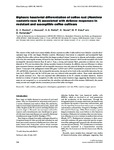Please use this identifier to cite or link to this item:
http://www.alice.cnptia.embrapa.br/alice/handle/doc/880368| Title: | Biphasic haustorial differentiation of coffee rust (Hemileia vastatrix race II) associated with defense responses in resistant and susceptible coffee cultivars. |
| Authors: | RAMIRO, D. A.  ESCOUTE, J.   PETITOT, A.-S.   NICOLE, M.   MALUF, M. P.   FERNANDEZ, D.   |
| Affiliation: | INSTITUTE DE RECHERCHE POUR LE DEVELOPPEMENT; CIRAD; INSTITUTE DE RECHERCHE POUR LE DEVELOPPEMENT; INSTITUTE DE RECHERCHE POUR LE DEVELOPPEMENT; MIRIAN PEREZ MALUF, SAPC; INSTITUTE DE RECHERCHE POUR LE DEVELOPPEMENT. |
| Date Issued: | 2009 |
| Citation: | In.: PLANT PATHOLOGY, v. 58, p. 944-955, 2009. |
| Description: | The objective of this study was to assess whether defence responses in coffee (Coffea arabica) were linked to a specific developmental stage of the rust fungus Hemileia vastatrix. Histological observations in compatible and incompatible highyielding Brazilian coffee cultivars showed that the fungus produced ?pioneer? haustoria in adjacent and subsidiary stomatal cells soon after entering the stomata, followed by later developed ?secondary haustoria? which invade mesophyll cells. In the incompatible interaction between Race II and cv. Tupi, a strong and transient H2O2 generation at infection sites was detected at 39 h post inoculation (hpi) during secondary haustoria formation. In addition, clear-cut differences in defence gene expression between compatible and incompatible interactions were only observed during the secondary haustoria formation. Transcripts of the pathogenesis-related (PR) genes CaPR1b and CaPR10 accumulated to maximal levels at 39 hpi (38- and 86-fold, respectively) in the incompatible interaction, but stayed at low levels in the compatible interaction. In contrast, the CaWRKY1 gene and the CaRLK gene were only induced in the susceptible cultivar. These results indicated that the specific resistance of cv. Tupi was expressed after differentiation of the H. vastatrix secondary haustoria. Analysis showed no evidence of specific recognition of coffee rust at the pioneer haustoria stage, suggesting that haustoria components are not recognized by, or not secreted into, the subsidiary and adjacent cells of the stomata. Additionally, the present study provides new insights into the colonization process of the coffee rust fungus. |
| Thesagro: | Coffea Arábica |
| NAL Thesaurus: | Reactive oxygen species |
| Keywords: | Quantitative real-time PCR Pathogenesis-related genes |
| Type of Material: | Artigo de periódico |
| Access: | openAccess |
| Appears in Collections: | Artigo em periódico indexado (SAPC)  |
Files in This Item:
| File | Description | Size | Format | |
|---|---|---|---|---|
| Biphasichaustorial.pdf | 558,44 kB | Adobe PDF |  View/Open |









